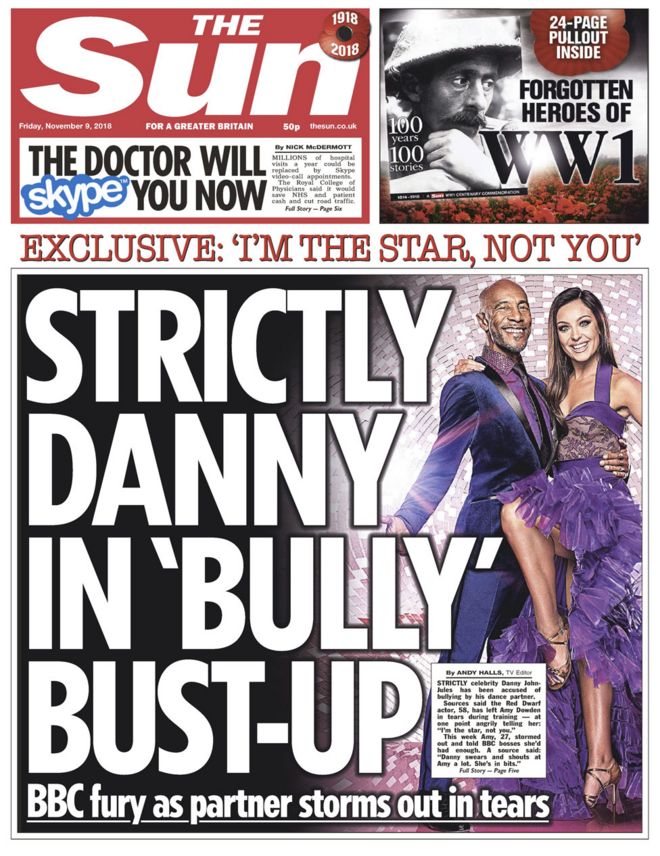Friday, 23 November 2018
Thursday, 22 November 2018
Essay on Newspaper decline
Print sales have declined for a number of reasons. The first
reason is the rise of the internet, and more specifically social media. More
and more people have a presence online and are spending more and more time on
their phones. Every day articles are posted online, and journalists are posting
things online, so hundreds of thousands of people see articles online for free,
which is much easier and cheaper than buying a newspaper. This is also the case
for businessman who are on the train every morning on the way to work. They can
look at the news on their electronic devices for free, and it is often easier
to read than a physical newspaper, as the websites are customizable. This means
that if you have an account for that website (which is normally free), then you
can specify what articles you want to see, so if you don’t want to see Brexit,
you don’t have to. This makes it a lot quicker to read the news for busy
people.
Even though there has been a decline in print news
circulation, the rise in online technologies and accessibility has enabled
newspapers to expand their audiences, specifically to younger people as they
would be unlikely to buy print newspapers, whereas they are always on their
phones, so newspapers and the news in general in much easier to access, and
free on most websites, except the Times and the Financial Times. Therefore, although
the print sales have declined, at the same time newspapers have increased their
audience by allowing people to read the news in different ways, so it is
accessible easily to almost everybody.
Another way newspaper sales have declined is due to citizen
journalism, participatory media and relationships with the audiences changing.
Citizen journalism has increased due to the internet and social media, so when
news stories are released online, people very quickly can work out how true the
story is, and if it isn’t true, then there can be a lot of backlash for whoever
posted the story. This can lead to newspapers building a certain reputation, so
it deters people from buying their papers. The increase in participatory media
is similar to this, as it is the audiences participating in the news, mostly by
commenting on an online news article or posting about it on social media. This
means that people can debunk stories if they have heard other information from
more reliable sources and then comment on the original post with what they
heard, which can instantly turn people’s heads away from that website.
This change is all shown in these statistics – the daily
circulation for the daily mail is 1,228,002, but the daily number of website
visits from adults is 169,400,000 on PC alone. This shows how big the news is
now becoming online, and although print sales have declined, the online
presence has rapidly increased. This is the same as the Guardian, which has
daily circulation figures of 135,330, and 1,176,000 website visits from adults
on PC.
Wednesday, 14 November 2018
George Gerbner Cultivation theory
Cultivation theory - the repetition of images, stories etc begins to shape our beliefs.
Tuesday, 13 November 2018
Front pages analysis
.
Tabloid:
This is The Sun front page from today (9/11/18), and the main story is to do with celebrities and, more specifically Strictly Come Dancing, despite there being other important events happening in the world today. For example, yesterday there was a wildfire in Florida.

Broadsheet:
This is the Times from today (9/11/18), and the main story is about Brexit, and there are multiple stories on the front page, whereas there is only 1 or maybe two main stories, with a much larger picture and larger and bolder text. On the broadsheet, there is a lot more text with more detail, so is for a older target audience.
Mid-Market Tabloids:
The mid-market tabloids are similar to the normal tabloids as they often avoid front page news on politics, and prefer to show stories to do with celebrities or, with the Daily Express, the weather. The Daily Express has a reputation of a panic obsession with weather.
Monday, 12 November 2018
Today's Newspapers screen recording
In this video you see the broadsheet newspapers first, which has more political than the tabloids, with a lot of news on Brexit, and the mid-term elections in the US. Then, moving on to the Tabloid papers, straight away we notice how the majority of the page is taken up by pictures, with the main topic being the viral video of people burning a Grenfell Tower model on a bonfire. As well as this, the other main topics are all to do with celebrities.
From the headlines and main stories of these newspapers, we can tell that the broadsheets are aimed at an older audience, due to the lack of pictures and amount of text there is.
Wednesday, 7 November 2018
Tuesday, 6 November 2018
Newspaper - Language
Tabloid vs Broadsheets
Broadsheets:
Broadsheets:
- politics
- more detail
- simple font
- 70% text, 30% images
- less colour
- aimed at more intelligent people
Tabloids:
- pictures
- celebrities
- less text
- larger text
- more colourful
- bold text
- capitals
- entertainment
- 80% images, 20% text
Monday, 5 November 2018
Industry notes
1980s - 50 companies owned 90% of the media
2011 - 6 companies
2015 - comcast highest revenue company - biggest cable provider - half the access to internet in the US.
Disney - £48 billion - ABC, ESPN, Pixar, Marvel, Lucasfilm.
21st century Fox - advertising - $800 million
Time Warner - lost $100 billion in 2002 when merged with AOL. 2004 they separated.
UK media:
3 companies control 71% of national newspaper circulation. The BBC is a public service broadcaster - doesn't rely on pleasing advertisers.
Theorists:
2011 - 6 companies
2015 - comcast highest revenue company - biggest cable provider - half the access to internet in the US.
Disney - £48 billion - ABC, ESPN, Pixar, Marvel, Lucasfilm.
21st century Fox - advertising - $800 million
Time Warner - lost $100 billion in 2002 when merged with AOL. 2004 they separated.
UK media:
3 companies control 71% of national newspaper circulation. The BBC is a public service broadcaster - doesn't rely on pleasing advertisers.
Theorists:
- Curran and Seaton - power in media industries.
- Livingstone and Lunt - regulation.
- Hesmondalgh - cultural industries.
Media convergence - when audiences use one platform to consume various types of media texts.
Media format - type of media e.g. video, print based.
Media platform - where media text is presented e.g. TV, cinema, magazine etc.
Marketing and promotion:
- celeb endorsement
- cross media campaigns
- market research
Audience Notes
Demographic Profiling:
A - higher management, bankers, lawyers, doctors etc.
B - middle management, teachers, creative and media people.
C1 - office supervisors, junior managements, nurses, white collar jobs, specialist clerical jobs.
A,B,C1 - target more expensive supermarkets and products.
Psychographic profiling:
Mainstreamers - largest group - security - live comfortably.
Aspirers - seek status. Younger people.
Succeeders - seek control - higher management and professionals.
Resigned - seek survival - older people.
Explorers - seeks discovery.
Strugglers - seeks escape - alienated and disorganised.
Reformers - seeks enlightenment.
A - higher management, bankers, lawyers, doctors etc.
B - middle management, teachers, creative and media people.
C1 - office supervisors, junior managements, nurses, white collar jobs, specialist clerical jobs.
A,B,C1 - target more expensive supermarkets and products.
Psychographic profiling:
Mainstreamers - largest group - security - live comfortably.
Aspirers - seek status. Younger people.
Succeeders - seek control - higher management and professionals.
Resigned - seek survival - older people.
Explorers - seeks discovery.
Strugglers - seeks escape - alienated and disorganised.
Reformers - seeks enlightenment.
Thursday, 1 November 2018
Advert Evaluation
The task we were given was to make a sweet advert for middle aged men. We tried to sell the product to that audience by showing that it would give men working in the city who are stressed during the day a boost of energy to make them stronger and feel more alive. The name of our brand was City Bears.
I worked with Joe Collins and Nathan. We each had equal roles in acting, camera work, planning and editing.
We planned our advert scene by scene, brainstorming ideas of how we wanted it to start and end the advert. This meant we could write down lots of ideas for each scene, and narrow it down to make sure the video came together well.
We researched different songs for parts of the advert to make sure we found the right song that fits the genre, we watched other adverts for inspiration and created a logo for our product.
I think that overall the advert went well, especially the choice of music and where we cut each scene, however we could have improved the advert by adding some more special effects to add to the feeling of strength that was shown in the video.
I worked with Joe Collins and Nathan. We each had equal roles in acting, camera work, planning and editing.
We planned our advert scene by scene, brainstorming ideas of how we wanted it to start and end the advert. This meant we could write down lots of ideas for each scene, and narrow it down to make sure the video came together well.
We researched different songs for parts of the advert to make sure we found the right song that fits the genre, we watched other adverts for inspiration and created a logo for our product.
I think that overall the advert went well, especially the choice of music and where we cut each scene, however we could have improved the advert by adding some more special effects to add to the feeling of strength that was shown in the video.
Subscribe to:
Comments (Atom)



